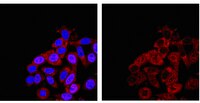03-200 Sigma-AldrichRIPAb+ SMN - RIP Validated Antibody and Primer Set
This RIPAb+ SMN -RIP Validated Antibody & Primer Set conveniently includes the antibody & the specific control PCR primers.
More>> This RIPAb+ SMN -RIP Validated Antibody & Primer Set conveniently includes the antibody & the specific control PCR primers. Less<<Recommended Products
Overview
| Replacement Information |
|---|
Key Spec Table
| Species Reactivity | Key Applications |
|---|---|
| H, M, Xn | RIP, WB, ICC, IP |
| References |
|---|
| Product Information | |
|---|---|
| Format | Purified |
| Control |
|
| Presentation | Anti-SMN (Mouse Monoclonal). One vial containing 50 µg of protein G purified monoclonal IgG1ĸ in buffer containing 0.1 M Tris-glycine, 150 mM NaCl, pH 7.4, 0.05% sodium azide before the addition of 30% glycerol. Store at -20°C. Normal Mouse IgG. One vial containing 125 µg of purified mouse IgG in 125 µL of storage buffer containing 0.1% sodium azide. Store at -20°C. RIP Primers, U1snRNA. One vial containing 75 μL of 5 μM of each primer specific for the cDNA of U1 snRNP. Store at -20°C. FOR: GGG AGA TAC CAT GAT CAC GAA GGT REV: CCA CAA ATT ATG CAG TCG AGT TTC CC |
| Quality Level | MQ100 |
| Physicochemical Information |
|---|
| Dimensions |
|---|
| Materials Information |
|---|
| Toxicological Information |
|---|
| Safety Information according to GHS |
|---|
| Safety Information |
|---|
| Packaging Information | |
|---|---|
| Material Size | 10 assays |
| Material Package | 10 assays per set. Recommended use: ~5 μg of antibody per RIP (dependent upon biological context). |
| Transport Information |
|---|
| Supplemental Information |
|---|
| Specifications |
|---|
| Global Trade Item Number | |
|---|---|
| Catalogue Number | GTIN |
| 03-200 | 04053252480621 |
Documentation
RIPAb+ SMN - RIP Validated Antibody and Primer Set Certificates of Analysis
| Title | Lot Number |
|---|---|
| RIPAb+ SMN - 2168284 | 2168284 |
| RIPAb+ SMN - 2325710 | 2325710 |
| RIPAb+ SMN - NRG1771802 | NRG1771802 |
| RIPAb+ SMN - NRG1771802A | NRG1771802A |
| RIPAb+ SMN -2511667 | 2511667 |
| RIPAb+ SMN -2684852 | 2684852 |


















